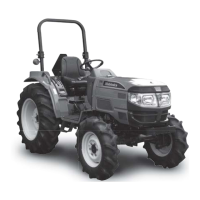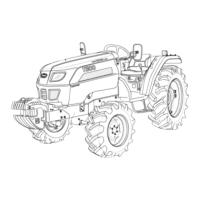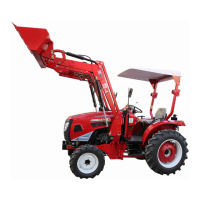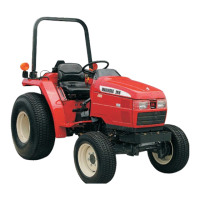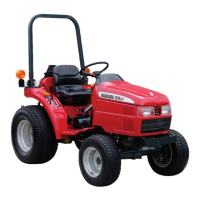H-13
35 Series 4WD, Model - 3535, 4035, 4535 and 5035 SM June’08
Steering
e) Inspect the piston rod bearing for excessive
wear or damage.
10. Assembly
a) Coat all internal parts with clean hydraulic
fluid.
b) Renew the O’rings and wiper seal then
assemble in the reverse order to dismantling.
NOTE: Discard and replace all seals, gaskets,
O’rings etc. Whenever a unit was taken
down for repair.
Do not attempt to lap or rework mated
parts with a high precision fit as this
will cause internal leakage.
11. Adjustment
On these tractors full piston stroke of the steering
cylinder is not utilized, but front wheels are stopped
by regular steering knuckle stopper. Stoppers are
factory adjusted and welded to give a definite front
wheel angle in lock position.
1. Place front wheel in central position and
check toe-in if necessary. Adjust tie rod length
to obtain a toe-in of 0.07” to 0.23”.
2. Mount steering cylinder pre-assembled to
specified length, to axle and steering lever.
3. Jackup tractor front axle. Turn wheels to both
directions, full lock, and make sure inside
wheels are stopped by lock stopper and not
by the end of piston stroke.
4. With inside wheels in full lock position. Make
sure there is a clearance of 0.004” between
front stopper of the outer wheels and front
axle stop.
5. Connect up pressure lines to their correct
cylinder port.
6. Tighten lock nuts of ball joints.
12. Testing
a. Unit may be tested after installation on the
machine.
b. Remove the air as per procedure given in
point no.6.
c. With the tractor standing on dry concrete and
the engine running at govern speed, operate
the steering for approximately five minutes.
d. With the engine stopped it should be possible
to rotate the steering from straight ahead
to full lock in approximately six seconds.
e. With the engine running at rated speed and
tractor standing on dry concrete, input torque
should not exceed 3.8 Nm.
f. Stop the engine, and using the special
spanner and a spring balance in the hole
further from the end check input torque does
not exceed 11.4 Nm Response must be
insantaneous.
Check the both directions.
g. With the engine running at maximum
rev/min. and steering wheel turned
appropriate lock the pressure of 100 Bar
must be recorded on a gauge fitted to one
of the cylinder hose.
h. With the engine running at rated speed
hydraulic oil temperature at 55
0
C ± 5
0
C.
Turn the wheels to the extreme left and right
lock and with a torque of 11.3 Nm.at steering
shaft, check steering slippage does not exceed
3 rev/min.
NOTE: If no suitable torque wrench is
available, the above slippage test can
be made with a spring scale. A pull of
approx. 8.8 lbs. at the steering wheel
rim equals the necessary test torque
6 lbs/ft.
i. Testing the power steering internal leakage
before and after repair.
a) Fill the cylinder with hydraulic fluid
(testing oil)
b) Connect a nozzle test pump to the inlet
port of the filled cylinder side.
c) Apply test pressure to determine leak
oil volume. See “Specifications”.
NOTE: A small amount of external leakage
(an oil moistered piston rod)
is acceptable.
13. Trouble Shooting General
When steering problems are encountered, the
following points should be checked first before
proceeding with fault spotting.
• Oil level in reservoir.
• Suction pipe and return oil filter condition.
• External oil leakage.

